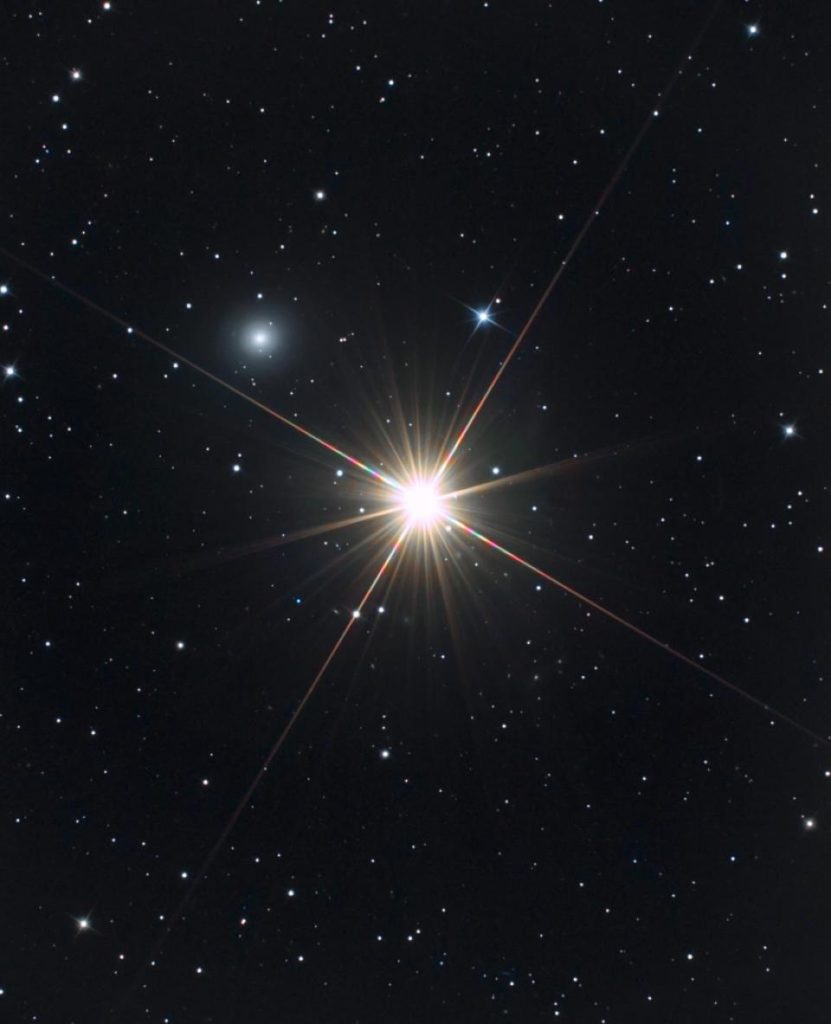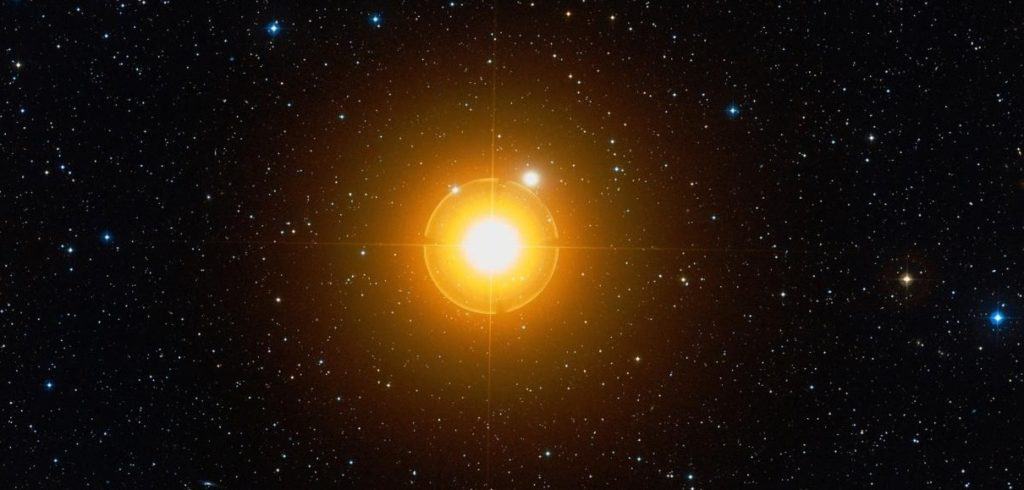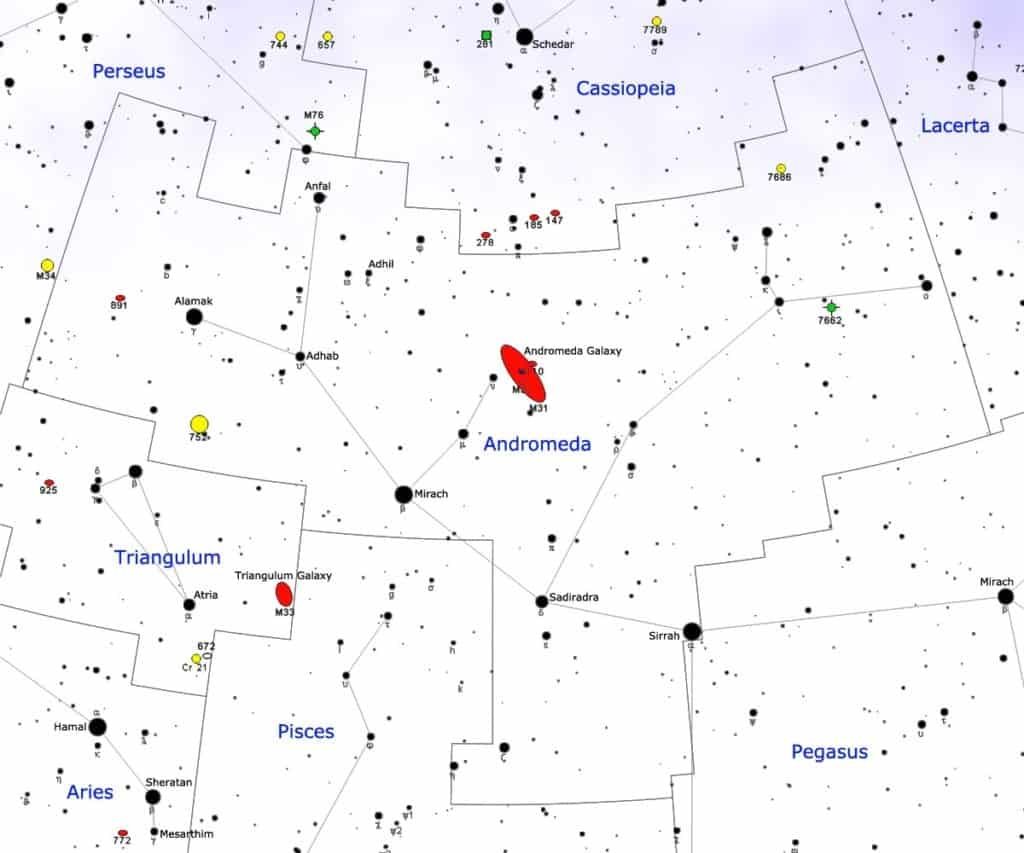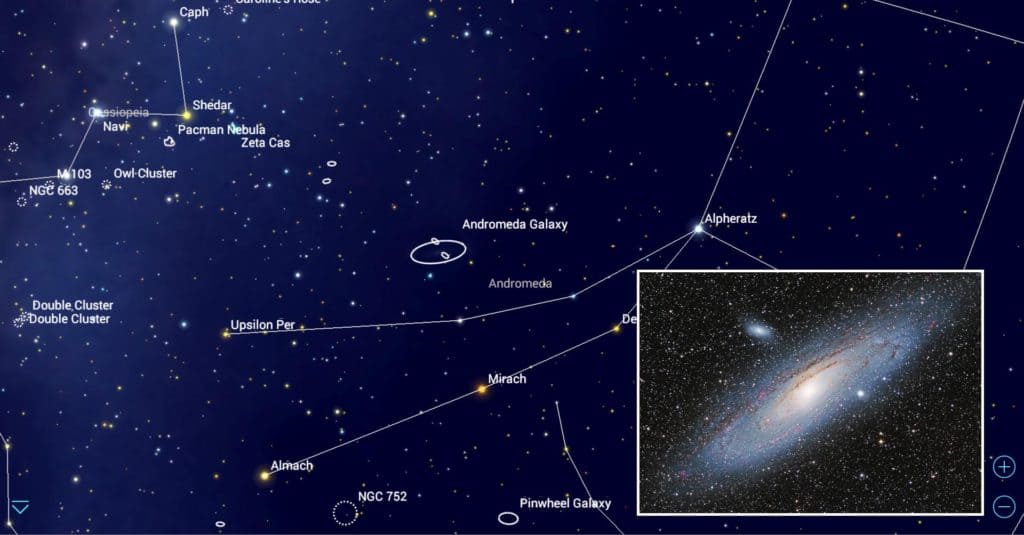Mirach, designated as Beta Andromedae, is usually the brightest star in the northern constellation of Andromeda. This star is used as a guide in finding the Andromeda (Messier 31), Triangulum (Messier 33), and NGC 404 galaxies.
Key Facts & Summary
- Mirach is located at around 197 light-years / 61 parsecs away from our Solar System.
- It is a single bright star, having an apparent magnitude of 2.05, which varies from magnitude +2.01 to +2.10, hence the reason why it is classified as a semiregular variable star.
- Its apparent magnitude is reduced by 0.09 by extinction due to gas and dust along the line of sight. Its absolute magnitude is -1.76.
- Mirach is a red giant star of spectral type M0 III.
- Since 1943, the spectrum of this star has been one of the stable anchor points by which other stars are classified.
- Mirach has between 3 and 4 solar masses, and a whopping 100 solar radii, making it around 200 times bigger than our Sun.
- This is attributed to its current stellar evolution, as Mirach continues to expand.
- Mirach is 1,995 times brighter than our Sun, however, it is cooler, having surface average temperatures of around 3,842 K.
- The radial velocity of this star has been measured at around 0.06 km / 0.03 mi per second.
- The surface gravity on this star is at 1.52 cgs.
- Mirach has a rotational velocity of around 7.2 km / 4.4 mi per second.
- Mirach is located northeast of the famous Great Square of Pegasus asterism. Its position makes it visible to all northern observers north of 54o S.
- Many stargazers often use Mirach to find the Andromeda Galaxy (Messier 31), the Triangulum Galaxy (Messier 33), or Mirach’s Ghost ( NGC 404), which is a galaxy situated at around seven arc minutes away from the star.
- Mirach’s age is currently unknown.
β Andromedae
Beta Andromedae has the traditional name Mirach, which translates to “girdle”, referencing the star’s position in the sky, as it marks Andromeda’s (the celestial princess) left hip.
There are many variations for this star’s name, such as Mirar, Mirac, Mirath, Mirak, etc. In Burritt’s Geography of the Heavens – the name of the star is spelled Merach, which comes from the star’s description in the Alfonsine Tables of 1521 as “super mizar”.

In this context, “mirat” is a corruption of the Arabic “mizar”, which appeared in a Latin translation of Ptolemy’s Almagest. In 2016, the IAU approved the name “Mirach” for Beta Andromedae.
Formation
Mirach was born out of an interstellar medium of gas and dust. Gravity pulled the swirling gas and dust together and resulted in the brightest star of Andromeda, Beta Andromedae. The star’s exact age is, however, currently unknown.
Distance, Size, and Mass
Mirach is located at around 197 light-years / 61 parsecs away from our Solar System. It is visible to the naked eye.

Due to its stellar evolution, Mirach has expanded considerably, as it possesses 100 solar radii, or 10,000% of our Sun’s radius, and between 3 to 4 solar masses, or 300% to 400% of our Sun’s mass. Mirach is thus around 200 times bigger than our Sun.
Other Characteristics
Mirach is a red giant star of spectral type M0 III. It is also a semiregular variable star, having an apparent magnitude of 2.05, which sometimes varies from magnitude 2.01 to 2.10. Its absolute magnitude is -1.76.
This star is 1,995 times brighter than our Sun, having an effective temperature of 3,842 K, thus it is cooler than our Sun. Mirach’s apparent magnitude is reduced by 0.09 by extinction due to gas and dust along its line of sight.

Since 1943, the spectrum of Mirach has been one of the stable anchor points by which other stars are classified. The radial velocity of this star has been measured at around 0.06 km / 0.03 mi per second. The surface gravity Mirach has been measured to be at around 1.52 cgs. Mirach has a rotational velocity of around 7.2 km / 4.4 mi per second.
Mirach is almost as bright as Nunki, which is located in the zodiacal constellation of Sagittarius. In comparison with other bright stars, Mirach is fainter than Hamal (zodiacal constellation of Aries), Diphda (in the constellation of Cetus), and it is brighter than Menkent ( in the constellation of Centaurus), Saiph (constellation of Orion), Rasalhague (constellation of Ophiuchus), Kochab ( constellation of Ursa Minor), and Algol, which is located in the constellation of Perseus.
Location
Mirach / Beta Andromedae is located in the constellation of Andromeda, the celestial princess. Its location in the sky mark’s the princess’s left hip.
Mirach is the brightest star in Andromeda, sharing the title with another bright star with very similar values, Alpheratz / Alpha Andromedae. Both stars are interestingly considered as the brightest in the constellation, however, Mirach is the true titleholder.

Mirach is positioned northeast of the famous Great Square of Pegasus asterism. Its location makes it visible to all northern observers north of 54o S. The famous asterism is used to find many interesting deep-sky objects, and Mirach is also a great guide towards some of them.
There are three famous galaxies that you can find by using Mirach / Beta Andromedae. The magnificent Andromeda Galaxy, designated as Messier 31, is located just 8 degrees northwest of Mirach.
The Triangulum Galaxy, designated as Messier 33, is also near Mirach, located at only 7 degrees southwest, while Mirach’s Ghost, designated as NGC 404, is a field galaxy located at seven arcminutes away from Mirach.

These galaxies are part of the Local Group of galaxies, which is where our Milky Way Galaxy is also situated. They are our brightest, largest neighbors, that are visible to the naked eye.

Andromeda has an apparent magnitude of 3.44, and it is located at around 2.54 million light-years, while Triangulum is at magnitude 5.72 and it is even farther away, at 2.73 million light-years.
The NGC 404 galaxy is located in the same field of view as Mirach, however, it is located at 10 million light-years from us, beyond the Local Group. It has an apparent magnitude of 11.2.

The constellation of Andromeda is among the first 48 Greek constellations, listed by the famous astronomer, Ptolemy, in his 2nd century Almagest.
Now, Andromeda is part of the 88 modern constellations, being the 19th largest in the sky, stretching for around 722 square degrees. Apart from the stars Mirach, and Alpheratz, and the Andromeda, Messier 32, and Messier 110, Andromeda hosts many other interesting stars and deep-sky objects.
Among them, there is the spiral galaxy NGC 891, the open clusters NGC 752, and NGC 7686, the planetary nebulae NGC 7662, or the orange giants Almach, Adhil, or Delta Andromedae, Titawin which hosts four confirmed exoplanets, or Ross 248, which is the 9th closest star to Earth, and the yellow-hued giant Veritate, among many others.
The best time of the year to observe the stars and deep-sky objects situated in the constellation of Andromeda is during the month of November.

For those interested in bright stars, here are the top 10 brightest stars in the constellation of Andromeda: Mirach – Beta Andromedae, at magnitude 2.05, Alpheratz – Alpha Andromedae, at magnitude 2.06, Almach – Gamma Andromedae, at magnitude 2.10, Delta Andromedae, at magnitude 3.28, Nembus – 51 Andromedae, at magnitude 3.57, Omicron Andromedae, at magnitude 3.62, Lambda Andromedae, at magnitude 3.8, Mu Andromedae, at magnitude 3.87, Zeta Andromedae, at magnitude 4.08, and Titawin – Upsilon Andromedae, at magnitude 4.10.
The Future
Mirach will continue on its stellar path for many millions of years, however, all-stars reach an end. When it comes to Mirach, it is not massive enough to end its life through a supernova explosion. Instead, Mirach will turn into a white dwarf after its outer layers will be blown into space.
Did you know?
- Mirach has a faint companion, a low-mass 14th magnitude main-sequence star, which is located at least 1,700 AU away.
- Some Latin alternative names for Mirach include Cingulum, which translates to “belt”, or “girdle”, and Ventrale, meaning “belly”. All names refer to the star’s position in the sky.
- In Arabic astronomy, Mirach is known as Janb al-Musalsalah – “the side of the chained lady” – It belonged to an Arabic lunar mansion known as “the belly of the fish” or “the heart of the fish”.
- The early Arabs named this star Al Risha – “the thread, or cord” – however, this name now applies to a star in Pisces, Alpha Piscium, known as Alrescha.
- Mirach is the star listed as KA.MUSH.I.KU.E. – the “Deleter” – in the Babylonian compendium known as the MUL.APIN. Some consider Alpha Cassiopeiae / Schedar, to be the star mentioned in the compendium.
- In Micronesia, Mirach was known as “Kyyw” – “the Porpoise” – which was also the name of one of the months of these ancient peoples.
- In Chinese, Mirach is known as KUI SU jiu – the Ninth Star of Legs – Legs – KUI SU – is a Chinese asterism that consists of many stars from the Andromeda and Pisces constellations.
Sources:
Image sources:
- https://science.nasa.gov/science-pink/s3fs-public/styles/image_gallery_scale_960w/public/atoms/MirachNGC404KentWood_1024.jpg?itok=VUyfVuPZ
- https://apod.nasa.gov/apod/image/1509/M31M33MirachMalcolm1024.jpg
- https://www.star-facts.com/wp-content/uploads/2019/10/Mirach.jpg
- https://www.star-facts.com/wp-content/uploads/2019/10/Andromeda-constellation.jpg
- https://www.star-facts.com/wp-content/uploads/2019/10/Mirach-location.jpg
- https://www.star-facts.com/wp-content/uploads/2019/10/Mirach-and-Mirachs-Ghost.jpg
- https://www.universeguide.com/pictures/constellations/stars/andromedalocationmirach.png
- https://cdn.mos.cms.futurecdn.net/RSNECUm3HXxgVkZfoUpjLj.jpg
